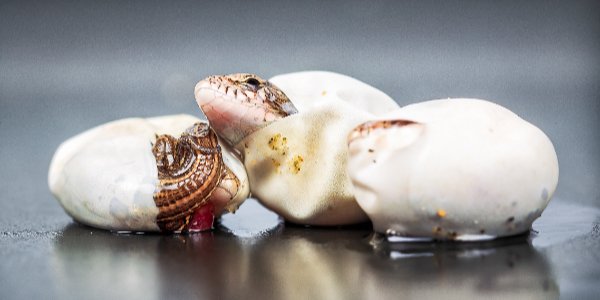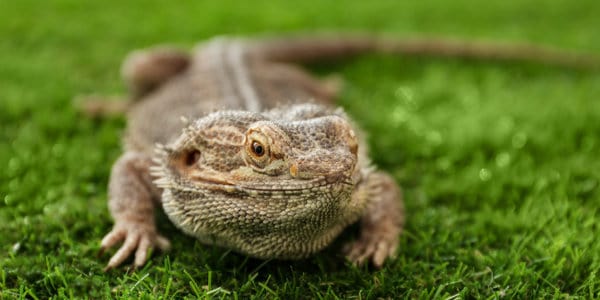Egg Laying in Bearded Dragons
Egg laying is the last thing anyone would think of when bringing a pet lizard home. However, whether you’ve planned for it or not, if you bring a female bearded dragon home, you might be shocked when you find eggs in its enclosure.
Although most people take bearded dragons’ egg-laying as an afterthought, knowing when to expect it will help you prepare and know what signs to watch. This guide will look at everything about bearded dragon egg-laying and answer all relevant questions.
Do All Bearded Dragons Lay Eggs? And at What Age?
Many female beardies will lay eggs at one point in their lives. And the surprising fact is that they can lay eggs even without being in contact with a male.
Reptile experts claim that these lizards can lay eggs from as early as eight months, which is even before they begin mating. However, only those between 2-4 years will lay viable eggs since their bodies are fully developed.
Some females may not lay eggs until later, and some even stay without laying eggs for their entire lifetime.
If a female bearded dragon has never come into contact with male beardies since it was bred, it might lack the hormones that induce egg-laying. However, this is a rare occurrence since nearly all females become gravid at one point and time in their lives.

How Frequently Do Bearded Dragons Lay Eggs?
As mentioned earlier, the most successful breeding age for female bearded dragons to breed is when they are 2 to 4 years. Vets warn against breeding dragons that are too young or too old. Egg-laying needs lots of energy, which young and old beardies lack.
There are disparities between one bearded dragon to the next when it comes to laying frequency. However, a female beardie lays an average of 4 to 6 clutches annually.
Every female has its timeline, though. Some female bearded dragons lay all eggs in two clutches spaced out over the year, while others lay the eggs continuously until they’re done.
Essentially, a female beardie’s ovary boasts two germinal beds, meaning that they have four germinal beds in total. These germinal beds can be active simultaneously, meaning that as one clutch is being laid, another one is being formed.
Another surprising fact is that female bearded dragons can store sperms for up to one year and use them to fertilize multiple germinal. Even after laying the first clutch, a female might not need to mate again to incubate a new set of eggs.
How Long After Mating Do Bearded Dragons Lay Eggs?
Although bearded dragons have a dizzying laying schedule, they’ll lay eggs after an average of 4-6 weeks after breeding. But remember, female beardies can store sperms for up to a year. This means they can stay for 12 months and get gravid again without the need to mate for a second time.
How Many Eggs Do Bearded Dragon Lay?
Female beardies lay eggs in groups known as clutches. The number of clutches a bearded dragon can lay during a mating season will depend on several factors such as proper nutrition, age, and size. Some produce fewer eggs per clutch, while others produce more.
Typically, female bearded dragons should produce 4- 6 clutches in a mating season. However, many females only manage 2-4 clutches annually. Additionally, a single clutch carries around 15 to 30+ eggs. However, these are just averages; some bearded dragons can produce more and others less.
Can Female Bearded Dragons Lay Infertile Eggs?
Like other reptiles, female bearded dragons don’t need a male to start laying eggs. Their reproductive hormones kick-start the egg formation process as soon as they attain the right age. And whether they have a mate or not, the eggs will come out of their bodies.
Females lay infertile eggs multiple times over their lifespan. However, they will need the same care in both circumstances, whether they lay fertile or infertile eggs.
However, infertile eggs have no use since they won’t develop into babies. Once you find infertile eggs in the enclosure, they should be removed from the enclosure and disposed of.
How Do You Differentiate Between a Fertile and an Infertile Egg?
If your beardie lays a clutch, but you’re unsure whether they are fertile or not. Infertile bearded dragon eggs are dented and slightly yellow, while fertilized eggs have a regular shape and have a more rigid shell.
But since the physical attributes don’t offer enough distinction, you need to perform the candle test by following these steps:
- Take the egg from the nest without changing its orientation and take it to a dark room
- Place it at the end of the flashlight and look at its internal contents
- If you see a pink embryo and a network of red veins originating it, this is probably a fertile egg.
- If the only visible thing is a yellow tint with nothing inside, this might be an unfertilized egg.
How Can You Tell That Your Female Bearded Dragon is Gravid (Pregnant)
When a female bearded dragon is carrying the eggs, it is said to be gravid. When your beardie is gravid, there are certain definitive physical and behavioral changes that you’ll start to see. These include:
- Weight gain: You’ll notice sudden weight gain, especially around the abdominal area
- Lethargy: Your beardie will become increasingly less active, especially when nearing the laying period.
- Loss of appetite: The lizard will eat less or refuse to eat at all
- Increased nesting behavior: Your bearded dragon will start showing nesting behaviors such as digging the ground and collecting litter in one place.
- Changes in excrement: A gravid beardie will change bowel movements and pass urates with a pinkish tinge.
How to Prepare Bearded Dragon for Egg Laying?
When a female bearded dragon is gravid, you need to supplement its calcium supply. Producing eggs uses a lot of calcium, and that’s why you need to replenish its stores.
Female bearded dragons draw calcium from the skeletal tissues to make eggs. If the calcium drawn from the bones is not supplied back, it leaves a void that makes beaded dragons susceptible to ailments like osteoporosis and metabolic bone disease.
If not well supplemented with calcium, bearded dragons can become weak and may start experiencing adverse symptoms. These include:
- Broken toes
- Tremors
- Bone fractures
- Deformation or swelling of jaws
- Broken toes, limbs, and even tail tips
Additionally, failure to give your bearded dragons enough calcium when they are gravid can lead to the formation of eggs with soft shells. Soft and sterile eggs can cause various complications to embryos and mothers.
Eggs without adequate calcium can crack and break during laying and allow infectious germs to pass through. The eggs might also become challenging to come out, leading to the mother becoming egg-bound.
Besides supplementing your female beardie with calcium, you also need to offer special treats and a balanced diet. More importantly, give your beardie regular warm baths to improve relaxation and hydration.

Health Concerns for Gravid Bearded Dragons
Several health issues may arise when female bearded dragons breed, carry and lay eggs. They include:
- Metabolic Bone Disease: This is a serious ailment caused by a calcium deficiency in bearded dragons. Since bearded dragons draw calcium to make eggs from bones and other skeletal tissues, they can drain the reserves and cause MDB.
- Egg Binding (Dystocia): This is where female beardies cannot lay their eggs even though they are already due. Various reasons may cause egg binding, but it’s more common and life-threatening in infertile reptiles.
- Egg Yolk Peritonitis: This condition occurs when eggs break while still inside the bearded dragon’s body. Egg-yolk bursts in the oviduct are serious as they might lead to internal infection and even death.
If you notice a behavior change or suspect that your bearded dragon is ailing from any of these conditions, you should visit a reptile or an exotic vet as soon as possible. This is because lizards don’t respond well to illnesses and may die after a short sickness.
Can I Prevent My Female Bearded Dragon from Laying Eggs?
Regrettably, there’s no mechanism to stop bearded dragons from laying eggs. Once they’re of age and the reproduction hormones kick in, there is nothing that you can do.
And to make matters worse, these creatures will lay eggs whether there’s a male around or not. The only remaining option is to be certainly sure that you buy a male dragon.
To Wrap It Up
Bearded dragons are egg-laying reptiles that need tender care when they become gravid. Whether you are a breeder or a regular pet owner, ovulation and egg-laying are compliments since they show that your bearded dragon is well-taken care of.
Although your pet beardie becoming gravid might seem like an inconvenience, planning for it can help your lizard successfully overcome the ordeal.
Providing your bearded dragon with calcium supplements and looking for any signs of illnesses during this period can make a difference.
We hope this piece provides definitive answers if you have questions about bearded dragon breeding and egg-laying.